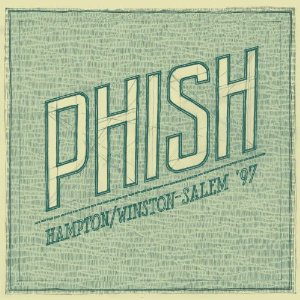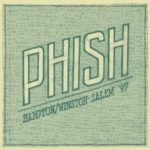
JEMP Records
1997 marked a significant turning point for Phish. No longer swallowed up in the long shadow painted by the Grateful Dead, the quartet finally broke free from their initial burst of composed gems and improvisational magic, and found their groove. And groove is the right word here. Beginning in early 1997 in Europe, the band played shows which featured a new form of tight-but-loose playing that somehow linked their former sound with something new all together. Those fresh strands of music were deeply rooted in funk, but there were other things happening, too.
For one, the band no longer appeared to want to construct the perfect show. Hell, they didn’t even seem to want to pander to their now vast audience. Instead, like any truly great artist, the collective looked within and discovered their muse. Setlists which were compiled in the past, were pretty much tossed aside by 1997 as the attempt to move from a cult band to an arena rock act had brought up new issues in 1996. What would the band do with this audience accumulated over the years through loyalty and sublime music? Would they try to lock into a form of music that was fun and palatable to a much wider audience, and yet not alienate the original core audience, which, dichotomically, seemed to be expanding exponentially? Jumping on a moving bus at 150 MPH somehow got to be a much trickier proposition as fans became curious about Phish, and forgot the one critical ingredient in the equation—the band no longer paid attention to fans. They began to listen to the possibilities of their music played in a very long and unplanned format.
So at the Great Went in August 1997, Phish requested that their fans build an art piece, which would include their own contributions, and go on to resemble a beautifully crazed monolith, in symbolic form, to what their relationship had been like over all the years.
And then they burned the fucker down.
By the fall of 1997, the quartet entered into a deeper zone of communication, which led all four members to truly listen to each other at all times. Was it always good? No. Was it always fun? No. Was it always different? No. Was it going somewhere new for the band and the audience? Yes. For arguably the first time, an improvisational rock band, a newly-minted ‘jamband’, found a way to morph free-form chaos with funk within a dream-like set that often appeared to segue from carefully-scripted imaginary notes.
Here we are. November 1997. Arguably one of the Holy Grails in the Phish archives is the November 22, 1997 gig. Per legend, the four lads from Vermont played a show for the ages, which featured mind-bending improvisation, twisted versions of old chestnuts, and a whole new frontier of groove-based music, which cemented Mike Gordon’s reputation as a sublime bassist, Page McConnell’s role as an astounding colorist, and Jon Fishman as a solid anchor-driven percussionist with more than a dash of post-jazz vibes.
Trey Anastasio. Big Red. Leader of the Band. Wilson. Phish frontman, guitarist, chief composer, and occasional reckless abandon administrator, Anastasio had been running at a fairly decent creative pace for over ten years by the time 1996 hit. Regardless of his past nicknames, or less than complimentary names to come as the 21st century dawned, the Phish leader found himself inheriting a majority of the Grateful Dead’s fans after the demise of Jerry Garcia in August 1995. Meanwhile, coupled with that fact, the band’s audience had slowly grown to a point where tens of thousands followed them around, instead of hundreds, making the spotlight shine even more on the talented figurehead.
In the wake of the flood of new fans, Phish carefully moved forward, while also producing their finest album, Billy Breathes, their most successful unified studio statement which encapsulated everything that is right and true about the band—their songs are timeless; they rock; they jam; they geek; Phish knows how to take you to a magical place when you are stoned. After that unique artistic totem, the band was unsure what to do next, played some fairly rote shows in the fall of 1996, and then found a weird link to their future by covering Talking Heads’ Remain in Light on Halloween.
The coke-fueled Heads’ funk classic found new life within the Phish framework, and the quartet subsequently discovered a new form of jamming. The quartet rode the back of a mighty worm, leading to some of their most inspired music of their career. Big Cypress loomed on December 31, 1999, after the funk mind-melded with ambient music to create new textures in 1998/99. But that epic career-defining New Year’s Eve peak could not have been possible without the groundbreaking 1997 work that was forged in the heady years leading up to that Florida watershed.
Here we are. November 1997. Again. The tapes have been out there circulating for many years, but to have pristine sets of soundboards from all three nights—Friday, November 21 and Saturday, November 22 in Hampton, Virginia, and Sunday, November 23 in Winston-Salem, North Carolina—has been on the wish list for…oh, well, 14 years now.
If you are a Phish fan, you get this seven-CD box set because it is the band during their PHISH DESTROYS AMERICA tour, and it’s a classic trio from the cow funk era.
But there is an argument that if you are not a fan of Phish, then there is music on here that is just as vital as any music made in the mid-to-latter part of the 20th century. I can say that with a straight face as I listen to this gloriously recorded package by Paul Languedoc, mastered by Fred Kevorkian, and post-production by Kevin Shapiro, because this is magnificent improvisation, which, ironically, appears to have been composed, arranged, and rehearsed. It also sounds like these four cats have practiced all of these twists and turns and mind fucks for quite some time. And they hadn’t. They just went out and played, and to hear music like this on these seven CDs is to hear a band that feels completely natural playing 100% naked and brilliant music in front of a willing audience.
Symbolically, the band laughs in the face of a requested older song (“Destiny Unbound”), and charges right into a landmark version of “Halley’s Comet,” which is so beautiful that one wishes that the band always played like this—open-ended and free; nothing to lose
and everything to gain as four band members add, enhance, develop, and rotate a groove. There are ZERO concessions to playing songs, or acknowledging their formidable canon. Instead, the band plays music, and stretches their path as far and wide as the mind can go.
Therefore, an argument can be made that, in a brief moment of cultural history, Phish created music that had never been heard before, and they did it without a second of preparation. They just went out, began a formal piece of music, tore it apart, broke it down into miniaturized pieces, picked it up, tossed it around, molded it back together, and then threw it out as far as it could go, sometimes arcing out towards an audience, oftentimes flying back and forth between each other on stage in a rare moment of
collective consciousness that only seems to happen in a live setting for this form of music. Phish became PHISH in 1997, and these shows are a perfect example of why this form of music is culturally significant when one wants to define art of the last century.
1997 marked a significant turning point for Phish. And what is important about these three shows isn’t that Phish debuted an 18-minute cover of the Rolling Stones’ “Emotional Rescue,” which defied all of its boundaries and went into another galaxy, or that they played four songs in the second set on the first night, which featured a 26-minute “AC/DC Bag,” segueing out of a transcendent “Ghost,” before dropping into a beautiful “Slave to the Traffic Light.” Or, as in the masterpiece that is November 22, the band opens with a “Mike’s Groove” that aims very high and lifts the audience to a height that will be maintained throughout on this glorious evening. Indeed, the crowd on this raucous Saturday night was as boisterous as Phish had ever seen, and the listener discovers the perfect marriage between risk-taking band and forward-thinking audience. The “Harry Hood” that followed the “Groove” defies logic and emotion, as each note of music seems like it is being played as a soaring and never-ending climax, instead of just a ‘song’ in a set, a prelude to Bigger Things, which is supposed to be a warm up for what is to come—the Great Inevitable in a Band’s Second Act. No, Phish did not warm up much on these three nights—first set, or otherwise. Instead, they took their preceding years, and used those shows as their springboard, and created new music from its glowing ashes.
The box set wisely contains the underrated third show of the trio run, a lone show in North Carolina’s Lawrence Joel Veterans Memorial Coliseum after the triumphant Hampton duo. On Sunday, for the second night in a row, the band explored the possibilities of the new funk instrumental, “Black-Eyed Katy” before its final destination of “The Moma Dance,” and this time, they curled even more dark textures within its possibilities in what appears to be an audio commentary on the entire run. “Fluffhead” was performed in what would seem a nod to a past, which no longer seemed to exist, and, yet, the song sounds fresh and alive in this context, perhaps for the first time in years.
In the second set in Winston-Salem, Phish continue to extend the horizons even further, expanding their sonic vocabulary, and twisting entire universes of sounds within their template, only to move through expanded originals in colossal form (a 32-minute “Bathtub Gin” is a soundboard headphone classic), only to drop into new jams with covers that seamlessly segue (a “Down With Disease” sandwich contains an 8-minute
slice of War’s “Low Rider,” which is transformed into a 3D version of white boy funk) in and out of powerhouse numbers with large jam engines.
To sweeten an already full-on cavity attack of deep complexity and richness on this 7-CD box set, Phish has also released “Hampton ’97 Soundcheck Jam” and “Back at the Chicken Shack,” which was soundchecked prior to the Winston-Salem gig. Mind you, this isn’t a festival soundcheck where the listener is enveloped in a 60-minute piece of majestic art, but this is Phish, and the Hampton soundcheck carries some intriguing weight over its 18 minutes of bliss before the gates opened and the flood ensued again.
In the end, the soundcheck is yet another example, on a fall 1997 release which has a well-documented legion of artistic peaks for the quartet, of how well the band listened to each other in a telepathic manner when no one was paying attention.
And you know what? You should.



No Comments comments associated with this post